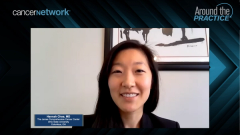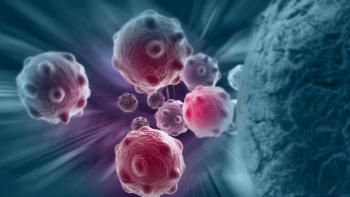
Treatment Approaches Using Ruxolitinib in GVHD
In a discussion on the use of ruxolitinib in GVHD, experts consider the potential role of dose reductions or dose holds to mitigate toxicity and comment on experiences with combining or sequencing therapies in later lines of treatment.
Episodes in this series

Transcript:
John F. DiPersio, MD, PhD: I want to ask 2 other questions, 1 about the toxicity associated with ruxolitinib over time in these patients. What are you doing with patients who become a little more anemic or a little more thrombocytopenic? Are you holding the dose, reducing the dose, or pushing on? Hannah?
Hannah Choe, MD: In general, I reduce the dose first. We start at the 10-mg twice-daily dosage, which is standard. If a patient starts to develop significant thrombocytopenia or anemia and sometimes neutropenia, then I’ll go down to 5 mg twice a day and monitor them. If I don’t see an improvement after a couple of weeks, I’ll start to lean them further and think about next-in-line therapy. Because at that point, you’re risking their GVHD [graft-vs-host disease] flaring as well coming off a lower dose.
John F. DiPersio, MD, PhD: Yi-Bin and Pashna, what do you think?
Yi-Bin Chen, MD: We do about the same. I’ve found the set of cytopenias to be manageable in the vast majority of patients. We do dose reductions for concurrent azoles because we know those interactions. For most people, we haven’t had to stop the drug and get by with those adjustments. But there’s a small subset where that becomes a big issue.
John F. DiPersio, MD, PhD: I have a question for you, Pashna. If someone is on ruxolitinib, and they are doing OK and stable but get a little worse, and you’re thinking about adding a second- or third-line agent like Rezurock, do you continue both drugs together or do you stop 1 and can start the other? If you start both, do you reduce the dose of 1 or both?
Pashna N. Munshi, MD: This is the question of current times: concurrent therapy vs giving it systematically? Do we do 1 or the other? Looking at the mechanism of action, it makes sense to try to do both together because ruxolitinib backs on the JAK1/JAK2 inhibition. Belumosudil clearly acts on the STAT pathway, but it also acts on an antifibrotic pathway. It adds to the mechanism of action of controlling chronic GVHD. Personally, I keep both drugs on if there are many systems involved in the patient with chronic GVHD. I try to manage it that way. Even the toxicity profile is a little different, so it’s an ideal marriage.
John F. DiPersio, MD, PhD: Yes, I agree.
Hannah Choe, MD: It’s a case-by-case basis. We’re starting to feel it out. We’re getting that real-world practical evidence. The reality is that it’s hard to completely go cold turkey off 1 therapy that a patient has been on for a long time and then start them on another, knowing that it might take several weeks to have an initial response. For some patients, we’ve been tapering them off the ruxolitinib for about a month while we start the belumosudil. In other cases, we’ll stop the ruxolitinib completely, start the belumosudil immediately, and then monitor. To be honest, it’s too early to say if there’s any difference. Anecdotally, we’re not seeing any difference between doing the 2 of them. I feel very comfortable stopping ruxolitinib completely before starting.
John F. DiPersio, MD, PhD: I continue both. I don’t make any dose reductions unless there are cytopenias and symptoms. I feel like they have completely different modes of action. Actually, 1 works on pathways in non–T-cell populations, and 1 works primarily on T-cell populations. I continue both. I don’t have enough anecdotal or randomized evidence to suggest that stopping 1 and continuing with the other is better than continuing with both. But this is the kind of thing that nobody would know unless you did a blinded prospective randomized trial. It’s hopeless otherwise. You’d have to have patient-reported outcomes too, because the patient has to tell us if he’s feeling or she’s feeling better.
Transcript edited for clarity.
Newsletter
Stay up to date on recent advances in the multidisciplinary approach to cancer.






















































































